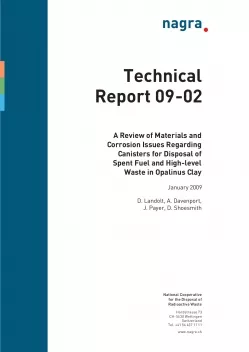
Technical Report NTB 09-02
A Review of Materials and Corrosion Issues Regarding Canisters for Disposal of Spent Fuel and High-level Waste in Opalinus Clay
The project "Entsorgungsnachweis" presented by Nagra to the Swiss Federal Government in December 2002 assessed the feasibility of disposal of spent fuel (SF), vitrified high level waste (HLW) from reprocessing and long-lived intermediate level waste in an Opalinus Clay repository site in Northern Switzerland. Nagra proposed the use of carbon steel canisters for disposal of SF/HLW and it also put forward an alternative concept of copper canisters with cast iron insert. In its reply the Federal Government acknowledged that Nagra had successfully demonstrated the technical feasibility of disposal of SF/HLW. However, some of its experts raised a number of questions related to the choice of steel as canister material. Among others, it was questioned whether hydrogen formed by corrosion of steel in contact with saturated bentonite might adversely affect the barrier function of the Opalinus clay. It was also recommended that alternative canister materials and/or design concepts should be evaluated.
To deal with these concerns Nagra convened an international group of experts, the Canister Materials Review Board (CMRB), who were to review the existing information on canister materials that could be suitable for the proposed repository environment. Based on present knowledge of materials science, the CMRB was to recommend to Nagra the most suitable material(s) for meeting the performance requirements for SF/HLW canisters. Specifically, the CMRB was to consider corrosion, including hydrogen generation, and stress-assisted failure processes that could affect the integrity and projected life time of SF/HLW canisters or impede the functioning of geological barriers while keeping in mind the overall feasibility of manufacturing, sealing and inspecting the canisters. The CMRB was further asked to identify the needs and provide advice for further studies by Nagra on the long term performance and safety of SF/HLW canisters in the Swiss repository concept.
For the assessment of the corrosion behavior of canisters, the CMRB distinguished four phases during which the corrosive environment is expected to gradually change from aerobic dry to anoxic wet conditions. Possible damage mechanisms of steel were identified for each phase and critically examined, including effects due to radiation, solid reaction products, microbial activity and the occurrence of stress assisted failures. The expected performance of other canister materials was also considered. The CMRB concludes that Nagra presents a convincing case that using steel canisters surrounded by bentonite as part of a multi-barrier system using Opalinus clay as the geological barrier is a viable concept for the safe disposal of SF/HLW under the assumption that the maximum acceptable hydrogen production rates given by Nagra can be confirmed in future. A few issues related to the long term performance of steel canisters need to be further elaborated and clarified by Nagra, but the CMRB found no major issue that would invalidate the use of steel canisters as part of the Nagra multi-barrier concept. The CMRB deems that the research program pursued by Nagra is carefully managed, effective and credible. Within the planning horizon for implementation of a repository for SF/HLW in Switzerland, the time table for canister development presented by Nagra is realistic. While vigorously pursuing the evaluation of the evolution of the near field environment and its effect on the corrosion of steel, Nagra should from now on initiate a comprehensive program on the evaluation of technological solutions for fabrication, welding, surface finishing and stress mitigation of thickwalled steel canisters.
